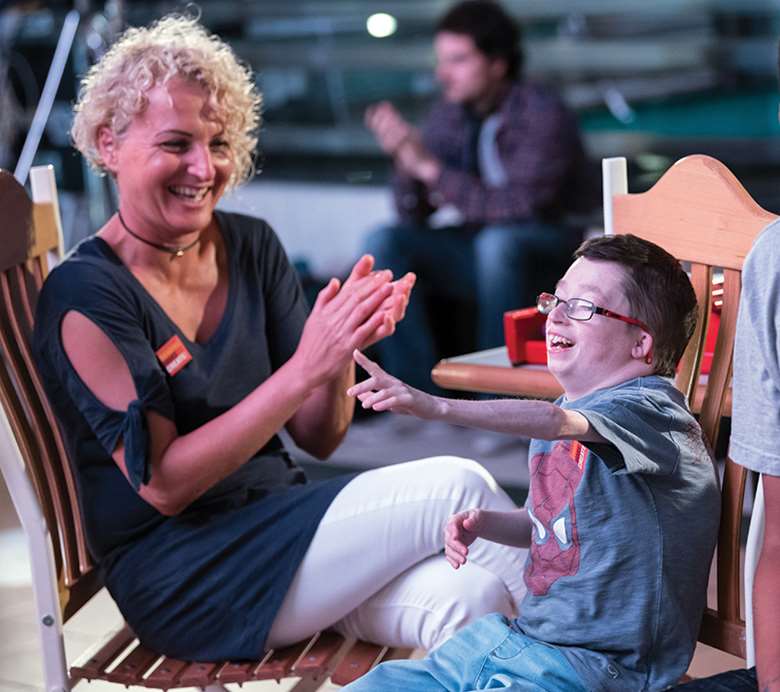Creative:connection
Nina Jacobs
Tuesday, July 31, 2018
UK charity uses art to break down barriers between disabled young people and able-bodied peers.

- Groups of young people work with artists to create projects that have long-term impact
- Participants' views are monitored throughout the initiative and after they leave to assess benefits
ACTION
Creative:connection is an innovative programme that brings together disabled and non-disabled young people to create art.
Established in 2013 by arts charity Create, the programme is designed to tackle disability prejudice through collaborative creativity.
Create co-founder and chief executive Nicky Goulder says research highlights close links between disability prejudice and access to the arts. She cites a study by disability charity Scope that showed 67 per cent of British people feel uncomfortable talking to someone with a disability. Meanwhile, research by the Arts Council found that people with disabilities are much less likely to participate in cultural activities with negative attitudes and prejudice the key reason.
Goulder says the main objective of creative:connection is to provide disabled and non-disabled young people equal access to the highest-quality creative experiences.
"It's about an opportunity to break down barriers and develop shared understanding between people with and without disabilities and that's a very important part of the work we do," she says.
Each creative:connection project is run by one of Create's artists, drawn from a pool of professional practising artists. Examples of those people engaged to run projects include playwrights, filmmakers, international dancers or fine artists.
Not only must the project leaders have professional experience in their own field but they must also display "exceptional skills and experience" in working with disadvantaged and vulnerable people, says Goulder.
Last year, nine projects were delivered through the programme, costing nearly £70,000.
"We design, deliver – and rigorously evaluate – professionally run programmes. That's how we are able to ensure the very highest standards of work," explains Goulder.
Recent initiatives organised under the creative:connection umbrella include a pairing of a mainstream school with a special school in Manchester for a large music project.
Participants created original pieces of music and songs as part of a one-week residency, which culminated in a performance at the Trafford Centre watched by an audience of 800 people.
"This was an incredible band of many musicians drawn from these schools many of whom had no previous musical experience," says Goulder. "It broke down barriers."
Another creative:connection scheme involved disabled and non-disabled young people in London where sculptors worked with pupils to create large willow animal figures to be housed in the special school's meadow.
Create focuses on working with children in deprived areas.
"We'll look at the deprivation indices, and the number of children entitled to free school meals because we want to reach out to the most disadvantaged and vulnerable participants," explains Goulder.
IMPACT
"For the last two years, 100 per cent of our community partner staff have rated the Create project successful overall," says Goulder.
Data is collected mainly through feedback questionnaires for participants, community partners as well as the professional artists involved in the project.
With a target of 100 per cent feedback for each project, Goulder says different formats are offered which are tailored to the needs of participants to aid response.
"For some it's written feedback but for others it could be a smiley face," she explains. "We work with the partner organisation to make sure the way we are collecting feedback is appropriate to the individuals."
Daily feedback circles are also held for the duration of each project to gather feedback from participants and staff.
Goulder says data is collected together with a participant's story, based on a one-to-one interview, and published in an evaluation report which is distributed to everyone involved in the project as well as Create's funders.
"We make sure that anything we are learning is implemented for future reports," she says.
Goulder says year-on-year participants report they are involved in creative activities, use creative thinking, have increased confidence and self-esteem as well as communication skills.
"We are trying to empower people by giving people the chance to develop skills and confidence for the long-term," she says.
Creative:connection was judged highly commended in the youth work category at the 2017 CYP Now Awards.
This article is part of CYP Now's special report on Youth Work Impact. Click here for more




